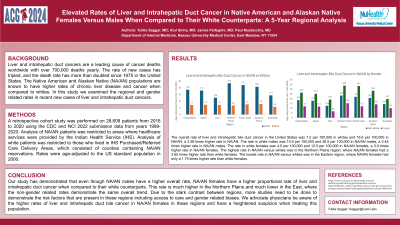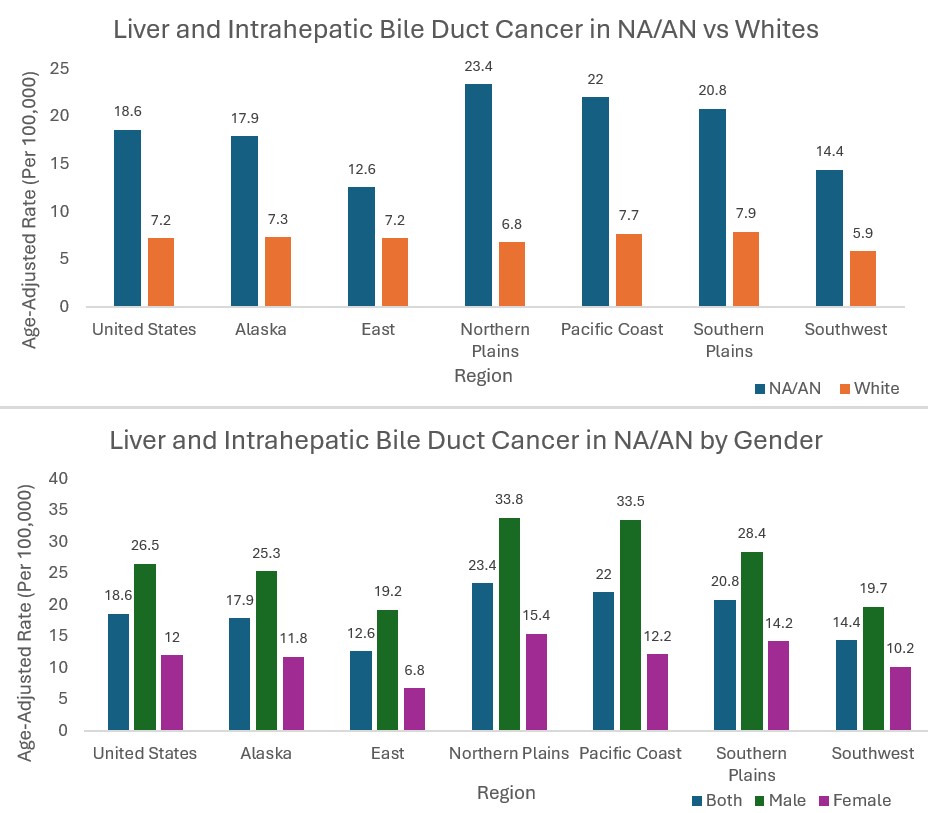Monday Poster Session
Category: Liver
P2968 - Elevated Rates of Liver and Intrahepatic Bile Duct Cancer in Native American and Alaskan Native Females vs to Males When Compared to Their White Counterparts: A 5-Year Regional Analysis
Monday, October 28, 2024
10:30 AM - 4:00 PM ET
Location: Exhibit Hall E

Has Audio

Tulika Saggar, MD
Nassau University Medical Center
East Meadow, NY
Presenting Author(s)
Award: Presidential Poster Award
Tulika Saggar, MD1, Atul Sinha, MD1, James R. Pellegrini, MD2, Paul Mustacchia, MD, MBA1
1Nassau University Medical Center, East Meadow, NY; 2Nassau University Medical Center, Great River, NY
Introduction: Liver and intrahepatic bile duct cancers are a leading cause of cancer deaths worldwide with over 700,000 deaths yearly. The rate of new cases has tripled, and the death rate has more than doubled since 1975 in the United States. The Native American and Alaskan Native (NA/AN) populations are known to have higher rates of chronic liver disease and cancer when compared to whites. In this study we examined the regional and gender related rates in recent new cases of liver and intrahepatic bile duct cancers.
Methods: A retrospective cohort study was performed on 28,609 patients from 2016 to 2020 using the CDC and NCI 2022 submission data from years 1999-2020. Analysis of NA/AN patients was restricted to areas where healthcare services were provided by the Indian Health Service (IHS). Analysis of white patients was restricted to those who lived in IHS Purchased/Referred Care Delivery Areas, which consisted of counties containing NA/AN reservations. Rates were age-adjusted to the US standard population in 2000.
Results: The overall rate of liver and intrahepatic bile duct cancer in the US was 7.2 per 100,000 in whites and 18.6 per 100,000 in NA/AN, a 2.58 times higher rate in NA/AN. The rate in white males was 10.8 per 100,000 and 26.5 per 100,000 in NA/AN males, a 2.45 times higher rate in NA/AN males. The rate in white females was 4.0 per 100,000 and 12.0 per 100,000 in NA/AN females, a 3.0 times higher rate in NA/AN females. The highest regional gender related rate in NA/AN versus whites was in the Northern Plains region, where NA/AN females had a 3.85 times higher rate than white females. The lowest regional gender related rate in NA/AN versus whites was in the Eastern region, where NA/AN females had only a 1.79 times higher rate than white females.
Discussion: Our study has demonstrated that even though NA/AN males have a higher overall rate, NA/AN females have a higher proportional rate of liver and intrahepatic bile duct cancer when compared to their white counterparts. This rate is much higher in the Northern Plains and much lower in the East, where the nongendered rates demonstrate the same overall trend. Due to the stark contrast between regions, more studies need to be done to demonstrate the risk factors that are present in these regions including access to care and gender related biases. We advocate physicians be aware of the higher rates of liver and intrahepatic duct bile cancer in NA/AN females in these regions and have a heightened suspicion when treating this population.

Disclosures:
Tulika Saggar, MD1, Atul Sinha, MD1, James R. Pellegrini, MD2, Paul Mustacchia, MD, MBA1. P2968 - Elevated Rates of Liver and Intrahepatic Bile Duct Cancer in Native American and Alaskan Native Females vs to Males When Compared to Their White Counterparts: A 5-Year Regional Analysis, ACG 2024 Annual Scientific Meeting Abstracts. Philadelphia, PA: American College of Gastroenterology.
Tulika Saggar, MD1, Atul Sinha, MD1, James R. Pellegrini, MD2, Paul Mustacchia, MD, MBA1
1Nassau University Medical Center, East Meadow, NY; 2Nassau University Medical Center, Great River, NY
Introduction: Liver and intrahepatic bile duct cancers are a leading cause of cancer deaths worldwide with over 700,000 deaths yearly. The rate of new cases has tripled, and the death rate has more than doubled since 1975 in the United States. The Native American and Alaskan Native (NA/AN) populations are known to have higher rates of chronic liver disease and cancer when compared to whites. In this study we examined the regional and gender related rates in recent new cases of liver and intrahepatic bile duct cancers.
Methods: A retrospective cohort study was performed on 28,609 patients from 2016 to 2020 using the CDC and NCI 2022 submission data from years 1999-2020. Analysis of NA/AN patients was restricted to areas where healthcare services were provided by the Indian Health Service (IHS). Analysis of white patients was restricted to those who lived in IHS Purchased/Referred Care Delivery Areas, which consisted of counties containing NA/AN reservations. Rates were age-adjusted to the US standard population in 2000.
Results: The overall rate of liver and intrahepatic bile duct cancer in the US was 7.2 per 100,000 in whites and 18.6 per 100,000 in NA/AN, a 2.58 times higher rate in NA/AN. The rate in white males was 10.8 per 100,000 and 26.5 per 100,000 in NA/AN males, a 2.45 times higher rate in NA/AN males. The rate in white females was 4.0 per 100,000 and 12.0 per 100,000 in NA/AN females, a 3.0 times higher rate in NA/AN females. The highest regional gender related rate in NA/AN versus whites was in the Northern Plains region, where NA/AN females had a 3.85 times higher rate than white females. The lowest regional gender related rate in NA/AN versus whites was in the Eastern region, where NA/AN females had only a 1.79 times higher rate than white females.
Discussion: Our study has demonstrated that even though NA/AN males have a higher overall rate, NA/AN females have a higher proportional rate of liver and intrahepatic bile duct cancer when compared to their white counterparts. This rate is much higher in the Northern Plains and much lower in the East, where the nongendered rates demonstrate the same overall trend. Due to the stark contrast between regions, more studies need to be done to demonstrate the risk factors that are present in these regions including access to care and gender related biases. We advocate physicians be aware of the higher rates of liver and intrahepatic duct bile cancer in NA/AN females in these regions and have a heightened suspicion when treating this population.

Figure: Figure 1: Age-adjusted rates of liver and intrahepatic bile duct cancer in Native American and Alaskan Natives compared to whites by region and by gender
Disclosures:
Tulika Saggar indicated no relevant financial relationships.
Atul Sinha indicated no relevant financial relationships.
James Pellegrini indicated no relevant financial relationships.
Paul Mustacchia indicated no relevant financial relationships.
Tulika Saggar, MD1, Atul Sinha, MD1, James R. Pellegrini, MD2, Paul Mustacchia, MD, MBA1. P2968 - Elevated Rates of Liver and Intrahepatic Bile Duct Cancer in Native American and Alaskan Native Females vs to Males When Compared to Their White Counterparts: A 5-Year Regional Analysis, ACG 2024 Annual Scientific Meeting Abstracts. Philadelphia, PA: American College of Gastroenterology.


